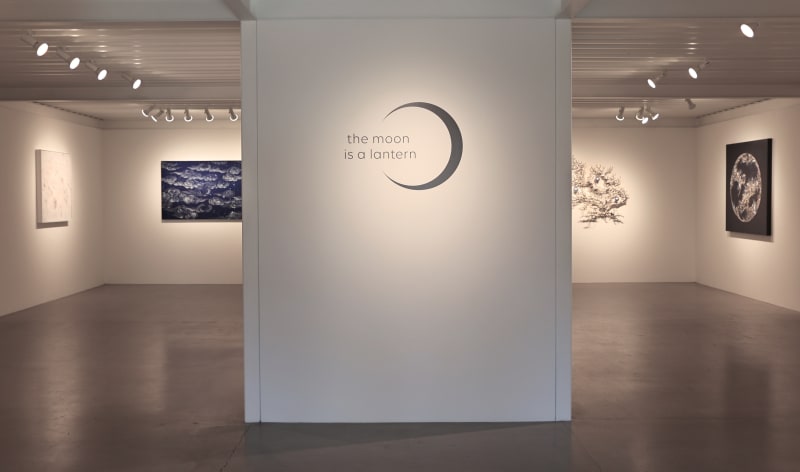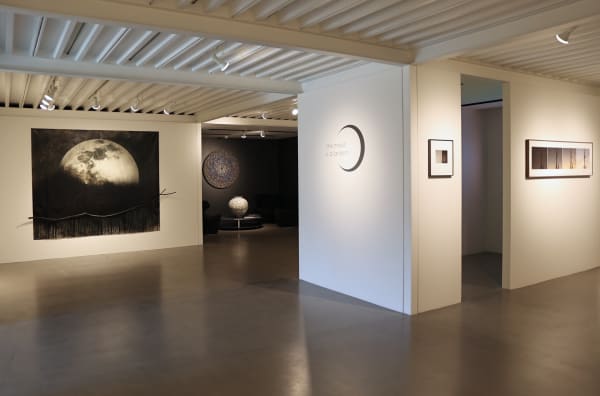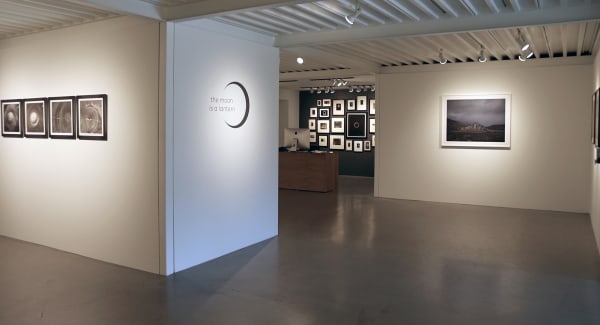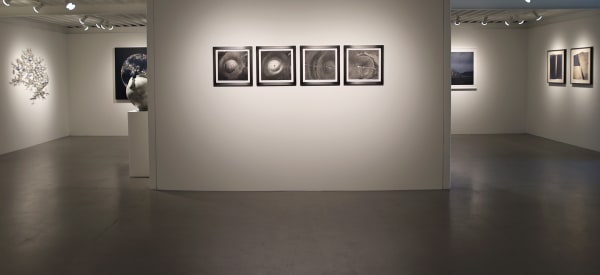The Moon is a Lantern
Drink wine and look at the moon and think of all the civilizations the moon has seen passing by.
- Omar Khayyám
In recent group shows including Subversive White, Temporary in Nature, and Wear Your Love Like Heaven, Lisa Sette Gallery takes on the challenge of envisioning the contemporary art space as a cultural conscience of the city, a place where creative experimentation sets a template for human and ecological transformation.
The Moon is a Lantern, opening October 14, 2023, continues this investigation with an exhibit of radically diverse artists and media, each turned toward Earth's only natural satellite as an allegory for change and remaking. In experimental works of photography, neon, resin, glass, porcelain, bronze, and painting, incorporating moon dust as a material and moonlight as a processing agent, 15 artists including Sam Chung, Binh Danh, Ala Ebtekar, Cameron Gainer, Timothy Horn, Mark Klett, Mayme Kratz, Richard Laugharn, Michael Lundgren, Marie Navarre, Luis González Palma, Shana and Robert ParkeHarrison, Charlotte Potter, Lily Reeves, and James Turrell consider Earth's moon as a contemporary metaphor and a sublime example, illuminating human darkness with a continuing cycle of renewal and reflection.
The Moon is a Lantern proposes that our planetary guidepost possesses literal and symbolic powers deriving from its movement and position: As we orbit the sun, so the moon orbits us, shaping our awareness of time, raising tides, and waking us to the radiance of night. The works in this exhibit follow the moon's refulgent light to discover the persistence of hope, the urgent need to re-envision our relationship with the Earth, and the shining beacon of our constant lunar counterpart as an example of our interconnectedness with the cosmos.
The Moon is a Lantern
Exhibition
October 14, 2023 - January 6, 2024
Opening Reception with the artists
Saturday, October 14, 2023
1:00 - 3:00pm
In recent group shows including Subversive White, Temporary in Nature, and Wear Your Love Like Heaven, Lisa Sette Gallery takes on the challenge of envisioning the contemporary art space as a cultural conscience of the city, a place where creative experimentation sets a template for human and ecological transformation.
The Moon is a Lantern, opening October 14, 2023, continues this investigation with an exhibit of radically diverse artists and media, each turned toward Earth's only natural satellite as an allegory for change and remaking. In experimental works of photography, neon, resin, glass, porcelain, bronze, and painting, incorporating moon dust as a material and moonlight as a processing agent, 15 artists including Sam Chung, Binh Danh, Ala Ebtekar, Cameron Gainer, Timothy Horn, Mark Klett, Mayme Kratz, Richard Laugharn, Michael Lundgren, Marie Navarre, Luis González Palma, Shana and Robert ParkeHarrison, Charlotte Potter, Lily Reeves, and James Turrell consider Earth's moon as a contemporary metaphor and a sublime example, illuminating human darkness with a continuing cycle of renewal and reflection.
The Moon is a Lantern proposes that our planetary guidepost possesses literal and symbolic powers deriving from its movement and position: As we orbit the sun, so the moon orbits us, shaping our awareness of time, raising tides, and waking us to the radiance of night. The works in this exhibit follow the moon's refulgent light to discover the persistence of hope, the urgent need to re-envision our relationship with the Earth, and the shining beacon of our constant lunar counterpart as an example of our interconnectedness with the cosmos.
In the revelation of an image or idea through exposure to light, there's something fundamentally photographic about our moon. The artists included in The Moon Is a Lantern address this analogue in intriguing ways. Ala Ebtekar uses light reflected from the moon in an experimental cyanotype process in which a ferrous solution is exposed to lunar light, producing the vivid cyan that distinguishes Ebtekar's swirling, stippled canvases. Influenced by writings of the 11th-century Islamic philosopher Suhrawardi, who proposed a framework for understanding the universe based on properties of illumination and intuition, Ebtekar's process becomes an alchemical technique merging material and myth, earth and sky.
With glimmering plated bronze and mirrored blown glass spheres, Timothy Horn's Gorgonia 16 (blue moon) draws a connection between human ornamentation and earth's living organisms, casting in silvery bronze the complex, myth-generating form of Gorgoniidae coral, interspersed with lantern-like iridescent spheres. Horn's breathtaking creation spans 6 feet, a reminder of the vast generative power of the Earth's seas and the equally immense perils that oceans and marine life confront in our anthropocene era.
Shana and Robert ParkeHarrison employ lunar metaphor to create a cautionary vision in The Distance, a photo collage in which a 1910 glass observatory slide of the moon descends into tar-like shadow, slung upon a charred branch: "We have all looked to the Moon for its wonder provoking qualities, its ability to transfix us, allow us to imagine. By imagining the moon engulfed in the fumes of its diseased planet, and simultaneously being cradled by a ritualized limb, we perform a dual intervention with this magical Moon, reminding the viewer that as humans we have the ingenuity to destroy or to create."
A product of cosmic collision, the moon's body is itself a map of fragmentation and repair; the scars on its visible surface a beacon to human curiosity. Cameron Gainer's Hypatia, an oil painting on panel, depicts the lunar crater named after Hypatia, a fourth century Egyptian mathematician, astronomer, and teacher, and the first female mathematician whose works were recorded during her lifetime. A singular portrait of Hypatia herself, and the endurance of human inquiry and imagination, Gainer's painted topography offers a close view of this monochromatic sphere whose composition is revealed to us in swelling and receding increments of brilliance.
The moon jar is one of the most iconic ceramic forms in Korea - revered for its simple, austere beauty. It rose to prominence in the 17th-18th centuries during the Joseon Dynasty. As a Korean-American artist, Sam Chung has always admired the generosity that the form exudes and the wide-open space it offers for reflection. The Asian cloud motif that is integrated into Chung's contemporary moon jars is a recurring theme and serves as a metaphor for living in between two cultures, a space that is constantly in flux.
The artist Charlotte Potter remarks, "I'm fascinated with the moon in this divided time as a great unifying lens of focus. This one celestial being is our muse, faithful companion and object of desire. I'm interested in our tidally locked position with the moon, that we only ever see one orientation." Potter will exhibit a series of glass cameos documenting lunar phases, in addition to two works into which she has incorporated material from the moon's surface: A blown-glass moon, its translucent spherical form patterned and mottled with regolith, presented like a miniature planet in a bell jar; and an hourglass form containing 13 minutes of moon sand, counting down the timespan of the first lunar landing. Curious, luminous, and desirable, Potter's objects exemplify the unrequited nature of our moon-like the ultimate internet avatar, an exquisite body that can be seen by all, but can never be possessed.
Illustrating the serene expanse of our universe, a place apart from human ego, Marie Navarre's silver gelatin diptych and Binh Danh's daguerreotype portraits of the moon share a spare aesthetic: silhouetted scythes of light floating in the depths of the upper atmosphere.
In contrast, Luis González Palma's La Luna 1 and La Luna 2 are entirely abstract but no less dramatic: folded bursts of black and white onion paper prints of negatives obtained from the archives of the Astronomical Observatory of the City of Cordoba, Argentina, where the artist lives. González Palma comments: "I explore in parallel the subject of portraiture and the universe as ways of investigating the sacred space inherent to the human being."
Throughout the moon's pattern of illumination, our sublunar doings are cast in various arrangements of shadow and light, as we undertake the ongoing journey from emptiness to fullness and back again. Each night we are reminded that we are creatures who live in a cosmic state of flux. The moon is a lantern, revealing a radiant path through current struggles and cycles of despair, a face that turns away from self and toward the universe. The moon, which is remade every night, may guide us in the remaking of our societies and civilizations.















